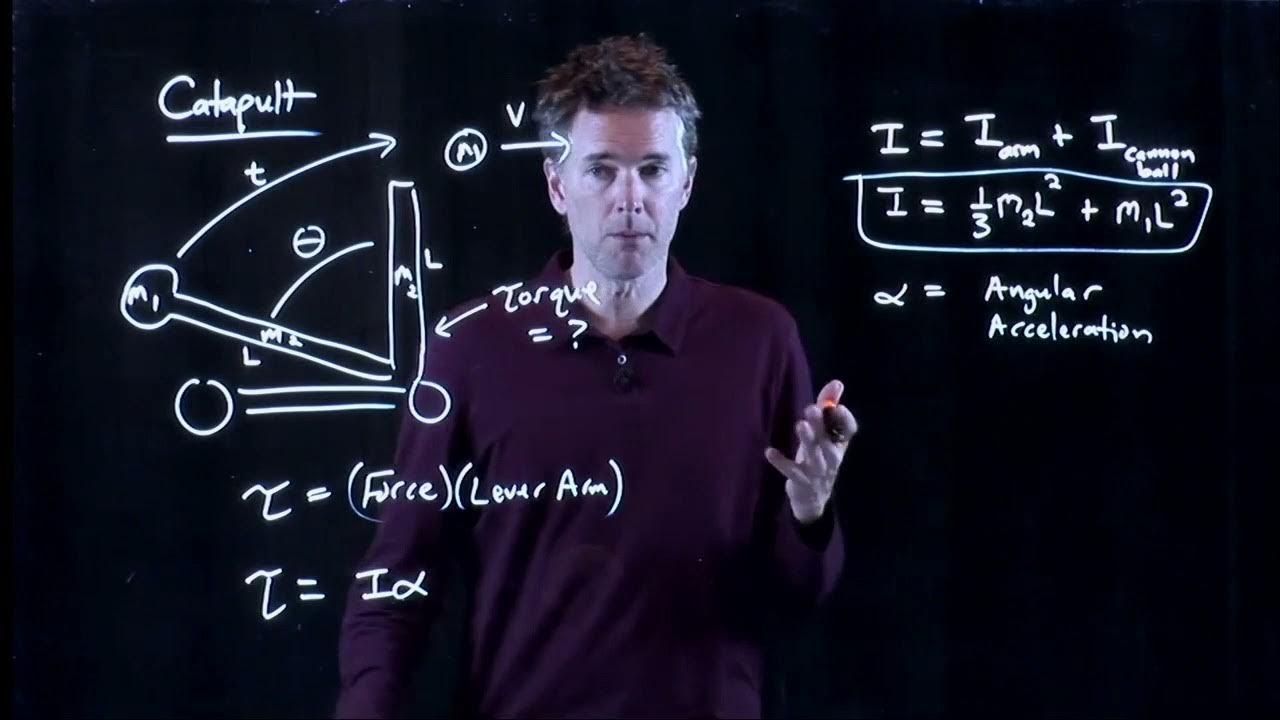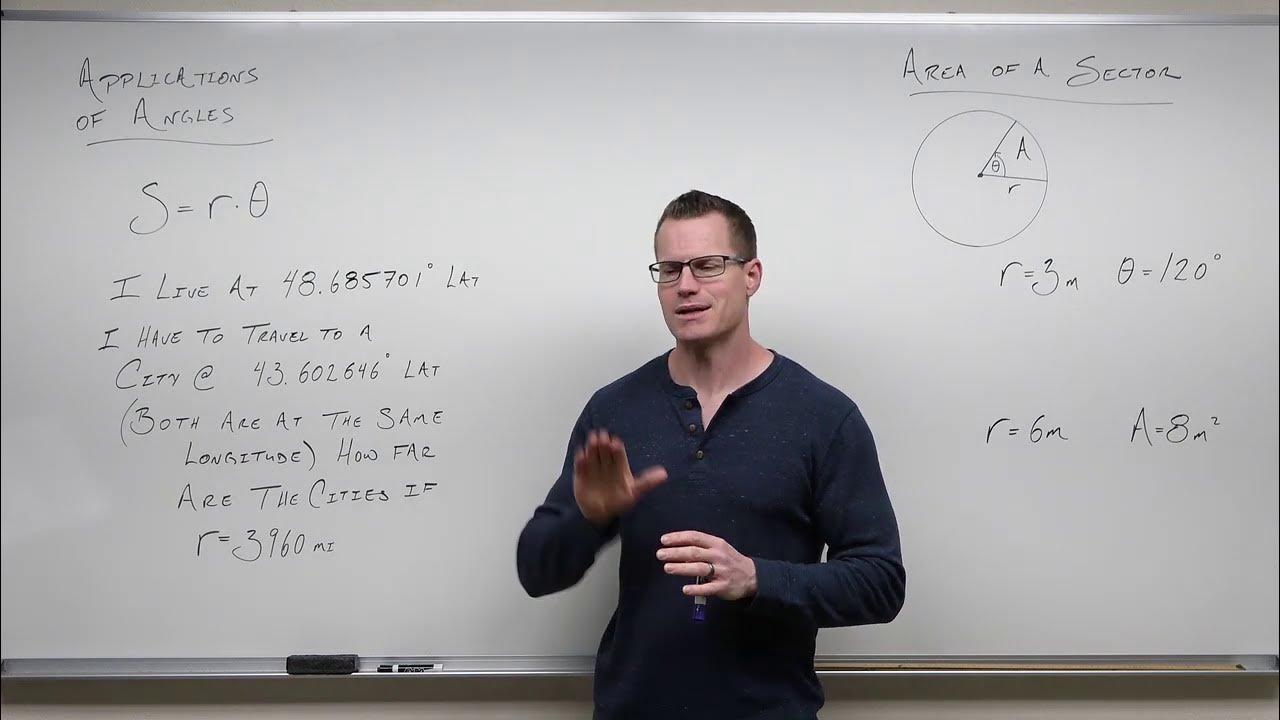Linear Speed and Angular Velocity
TLDRThis educational video script delves into the concepts of linear and angular speed, explaining their differences and calculations. Linear speed measures the rate of motion along a straight path, while angular speed pertains to the rate of rotation. The script introduces key equations, such as v = s/t for linear speed and ω = θ/t for angular speed, and emphasizes unit conversions like rpm to radians and meters to kilometers. It also demonstrates how to connect the two speeds through v = ωr and provides step-by-step examples to calculate linear speed from angular speed and vice versa, using various units and real-world scenarios like spinning wheels and moving vehicles.
Takeaways
- 🚗 Linear speed is the measure of how fast an object is moving in a straight line, such as a car traveling 40 miles per hour east.
- 🔄 Angular speed is the measure of how fast something is rotating, like a disc spinning at 30 revolutions per minute (rpm).
- ⚖️ Linear speed can be calculated using the formula \( v = \frac{s}{t} \), where \( v \) is velocity, \( s \) is arc length, and \( t \) is time.
- 📐 Angular speed is represented by the symbol omega (\( \omega \)) and is calculated with \( \omega = \frac{\theta}{t} \), where \( \theta \) is the angle in radians and \( t \) is time.
- 📏 Units for linear speed include meters per second, feet per second, miles per hour, and kilometers per hour.
- 🔢 Angular speed units are degrees per second, radians per second, and revolutions per minute (rpms).
- 🔗 The relationship between linear speed and angular speed is given by \( v = r \cdot \omega \), where \( r \) is the radius.
- 🔄 Conversion factors are essential for solving problems, such as 1 mile equals 5280 feet, 1 kilometer equals 1000 meters, and 1 revolution equals 2π radians.
- 📐 The radius can be thought of as length per unit radian, which simplifies calculations when dealing with circular motion.
- 📚 Examples in the script demonstrate how to calculate linear speed from angular speed using the radius and how to convert units to solve problems.
- 📉 The script also shows how to find angular speed from linear speed and vice versa, including unit conversions such as from kilometers per hour to radians per second.
Q & A
What is the primary difference between linear speed and angular speed?
-Linear speed refers to how fast an object is moving in a straight line, while angular speed refers to how fast an object is rotating.
How is linear speed typically described in the context of a car's movement?
-Linear speed is described in terms of miles per hour or kilometers per hour, indicating the distance the car travels in a given time period.
What is the unit of angular speed and what does it represent?
-Angular speed is measured in units like revolutions per minute (rpm), degrees per second, or radians per second, representing the rate of rotation.
Can you explain the formula for calculating linear speed in terms of a circle?
-The formula for calculating linear speed in terms of a circle is v = s/t, where 'v' is the linear speed, 's' is the arc length, and 't' is the time.
What is the symbol used to represent angular speed and what is its formula?
-The symbol used to represent angular speed is omega (ω), and its formula is ω = θ/t, where 'θ' is the angle and 't' is the time.
What is the relationship between linear speed and angular speed in terms of radius?
-The relationship between linear speed (v) and angular speed (ω) in terms of radius (r) is given by the equation v = r * ω.
How can you convert revolutions per minute (rpm) to radians per second?
-To convert rpm to radians per second, multiply the number of revolutions per minute by 2π, and then divide by 60 seconds.
What is the significance of the conversion factor 1 kilometer equals 1000 meters?
-The conversion factor 1 kilometer equals 1000 meters is used to convert distances from kilometers to meters, which is necessary for unit consistency in calculations.
Can you provide an example of how to calculate the linear speed of a wheel given its angular speed and radius?
-Yes, if a wheel has an angular speed of 8 radians per second and a radius of 5 centimeters, the linear speed (v) can be calculated as v = ω * r = 8 * 5 cm/s = 40 cm/s, which can be further converted to meters per second.
How do you convert linear speed from centimeters per second to meters per second?
-To convert linear speed from centimeters per second to meters per second, divide the speed in centimeters by 100, because there are 100 centimeters in a meter.
What is the process of converting angular speed from rpm to radians per second?
-To convert angular speed from rpm to radians per second, first convert rpm to revolutions per second by dividing by 60, then multiply by 2π to get the speed in radians per second.
Can you explain how to find the angular speed in radians per second given the linear speed and radius of a wheel?
-Yes, to find the angular speed in radians per second given the linear speed (v) and radius (r), you use the formula ω = v / r and then convert the units from feet per hour to radians per second as necessary.
What is the process to convert linear speed from kilometers per hour to miles per hour?
-To convert linear speed from kilometers per hour to miles per hour, multiply the speed in kilometers per hour by a conversion factor, typically 0.621371 (since 1 kilometer is approximately 0.621371 miles).
Outlines
🔄 Introduction to Linear and Angular Speed
The first paragraph introduces the concepts of linear and angular speed, explaining the difference between the two. Linear speed is described as the rate at which an object moves forward, such as a car traveling at 40 miles per hour. Angular speed, on the other hand, refers to the rate of rotation, exemplified by a disc spinning at 30 revolutions per minute (RPM). The paragraph also covers the basic equations for calculating each type of speed: linear speed (v = s/t) and angular speed (ω = θ/t). Units for linear speed include meters per second, feet per second, miles per hour, and kilometers per hour, while angular speed is measured in degrees per second, radians per second, or revolutions per minute (RPM). A key relationship between the two is also highlighted: linear speed equals the radius times angular speed (v = rω).
📏 Conversion Factors and Linear Speed Calculation
This paragraph delves into the importance of conversion factors in solving problems involving linear and angular speeds. It explains how to convert units like RPM to revolutions per minute, and provides common conversion factors such as one mile equals 5280 feet, and one kilometer equals 1000 meters. The paragraph also emphasizes the concept of the radius as length per unit radian, which is crucial for solving problems. An example problem is presented where a wheel with an angular speed of 8 radians per second and a radius of 5 centimeters is used to calculate the linear speed, resulting in 40 centimeters per second, which is then converted to 0.4 meters per second.
📐 Solving for Linear Speed in Different Units
The third paragraph continues the theme of unit conversion and problem-solving by addressing a scenario where a disc with a radius of four centimeters spins at 30 RPM. The goal is to find the linear speed in feet per second. The solution involves converting RPM to revolutions per minute, then to radians, and finally using the radius to convert to a unit of length. The conversion from centimeters to feet and minutes to seconds is detailed, leading to the calculation of the linear speed as 0.4123 feet per second. This step-by-step process is crucial for understanding how to manipulate units to arrive at the desired outcome.
⏱ Angular Speed Calculation and Unit Conversion
The fourth paragraph focuses on calculating angular speed and converting it to different units. It begins with a problem where a wheel makes ten revolutions every four seconds, leading to an angular speed of 2.5 revolutions per second, which is then converted to 5π radians per second. The subsequent part of the paragraph involves finding the linear speed in miles per hour given a radius of 0.5 feet and the previously calculated angular speed. The process includes converting radians to feet, feet per second to miles per hour, and involves time unit conversions from hours to minutes and seconds. The final answer for the linear speed is given as 5.35 miles per hour.
🚍 Calculating Angular Speed from Linear Speed
This paragraph presents a scenario where a bus with a wheel radius of 1.4 feet moves at a linear speed of 45 kilometers per hour, and the task is to find the angular speed in RPM. The process involves converting kilometers per hour to feet, using the radius to convert from feet to radians, and then calculating the angular speed in radians per hour. Further conversions are made to change hours to minutes and radians to revolutions, resulting in an angular speed of approximately 280 RPM.
🚚 Advanced Angular Speed Calculation
The final paragraph of the script provides a practice problem involving a truck with a wheel radius of 1.7 feet moving at a linear speed of 35 miles per hour. The goal is to calculate the angular speed in radians per second. The solution requires converting miles per hour to feet, using the radius to find the length of one radian, and then converting hours to seconds to arrive at the angular speed in the desired units. The calculated angular speed is 30.196 radians per second.
Mindmap
Keywords
💡Linear Speed
💡Angular Speed
💡Velocity
💡Arc Length
💡Radius
💡Revolutions Per Minute (RPM)
💡Radians
💡Unit Conversion
💡Meters Per Second
💡Radians Per Second
💡Conversion Factors
Highlights
Linear speed and angular speed are two different measures of motion.
Linear speed refers to the rate of motion along a straight path.
Angular speed is the rate of rotation around a fixed axis.
Linear speed can be calculated using the formula v = s/t, where v is velocity, s is distance, and t is time.
Angular speed is represented by the Greek letter omega (ω) and is calculated as ω = θ/t, where θ is the angle.
Units of linear speed include meters per second, feet per second, miles per hour, and kilometers per hour.
Units of angular speed are degrees per second, radians per second, and revolutions per minute (RPM).
The relationship between linear speed (v) and angular speed (ω) is given by v = r * ω, where r is the radius.
Conversion factors are essential for solving problems involving different units of measurement.
Understanding the concept of 'radius per unit radian' simplifies calculations involving circular motion.
An example problem demonstrates calculating the linear speed of a wheel given its angular speed and radius.
Conversion from centimeters per second to meters per second is necessary for standardizing speed units.
Another example shows how to find the linear speed in feet per second given a disc's radius and RPM.
The importance of unit conversion in calculating angular and linear speeds is emphasized.
A step-by-step process for converting RPM to radians per second is provided.
Calculating the linear speed in miles per hour from angular speed involves multiple unit conversions.
An example of finding the angular speed of a bus wheel given its radius and the bus's linear speed is presented.
The final example demonstrates calculating the angular speed of a truck wheel in radians per second.
Transcripts
Browse More Related Video

Spinning Ice Skater | Physics with Professor Matt Anderson | M12-02

Rotational Kinematics Physics Problems, Basic Introduction, Equations & Formulas

Circular Motion: Acceleration (Angular, Tangential, Centripetal)

Torque and the Catapult | Physics with Professor Matt Anderson | M12-07

Area of a Sector, Angular Velocity, Applications (Precalculus - Trigonometry 5)

Relating angular and regular motion variables | Physics | Khan Academy
5.0 / 5 (0 votes)
Thanks for rating: